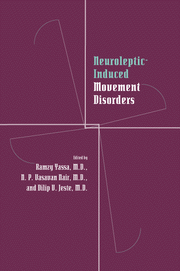Book contents
- Frontmatter
- Contents
- Contributors
- Preface
- Part I Historical perspective
- Part II Clinical aspects of tardive dyskinesia
- Part III Mechanisms underlying tardive dyskinesia
- Part IV Measurement of tardive dyskinesia
- Part V Tardive dyskinesia in different populations
- 19 Cultural aspects of tardive dyskinesia in Asia
- 20 Tardive dyskinesia in North America and the Middle East
- 21 Tardive dyskinesia in Europe
- 22 Role of ethnicity in the development of tardive dyskinesia
- 23 Tardive dyskinesia in children and adolescents
- Part VI Other neuroleptic-induced movement disorders
- Part VII Treatment of tardive dyskinesia
- Index
21 - Tardive dyskinesia in Europe
from Part V - Tardive dyskinesia in different populations
Published online by Cambridge University Press: 09 October 2009
- Frontmatter
- Contents
- Contributors
- Preface
- Part I Historical perspective
- Part II Clinical aspects of tardive dyskinesia
- Part III Mechanisms underlying tardive dyskinesia
- Part IV Measurement of tardive dyskinesia
- Part V Tardive dyskinesia in different populations
- 19 Cultural aspects of tardive dyskinesia in Asia
- 20 Tardive dyskinesia in North America and the Middle East
- 21 Tardive dyskinesia in Europe
- 22 Role of ethnicity in the development of tardive dyskinesia
- 23 Tardive dyskinesia in children and adolescents
- Part VI Other neuroleptic-induced movement disorders
- Part VII Treatment of tardive dyskinesia
- Index
Summary
Persistent dyskinesia was first recognized in the late 1950s in Germany (Schonecker, 1957) and France (Sigwald et al., 1959). Amid the surge of publications from Germany, Denmark, and the United Kingdom that followed those early case studies, an influential Danish study (Faurbye et al., 1964) introduced the term “tardive dyskinesia.”
This chapter reviews the studies from European countries that have examined the prevalence of tardive dyskinesia. Since the 1960s there has been a dearth of studies: Only three prevalence studies have come from Italy, and one each from Austria and Sweden; there have been none from Holland, Portugal, or Greece and, apart from Hungary, none from Eastern Europe. This review emphasizes the work from France, which had been excluded from recent major reviews (Jeste & Wyatt, 1982a; Kane & Smith, 1982; Morgenstern et al., 1987).
General Considerations
Genetic Factors
A genetic factor is likely to account for the predisposition to tardive dyskinesia. Family studies (Weinhold, Wegner, & Kane, 1981; Yassa & Ananth, 1981; Waddington & Youssef, 1988; Youssef, Lyster, & Youssef, 1989) have shown a concordance for tardive dyskinesia in first-degree relatives. This is not unexpected, for a familial genetic predisposition is found in druginduced parkinsonism (Myrianthopoulos, Kurland, & Kurland, 1962).
A genetic ethnic component is also possible. Chinese populations reportedly have a lower prevalence of tardive dyskinesia than do those of Western countries (Chiu et al., 1992).
- Type
- Chapter
- Information
- Neuroleptic-induced Movement DisordersA Comprehensive Survey, pp. 274 - 297Publisher: Cambridge University PressPrint publication year: 1996

